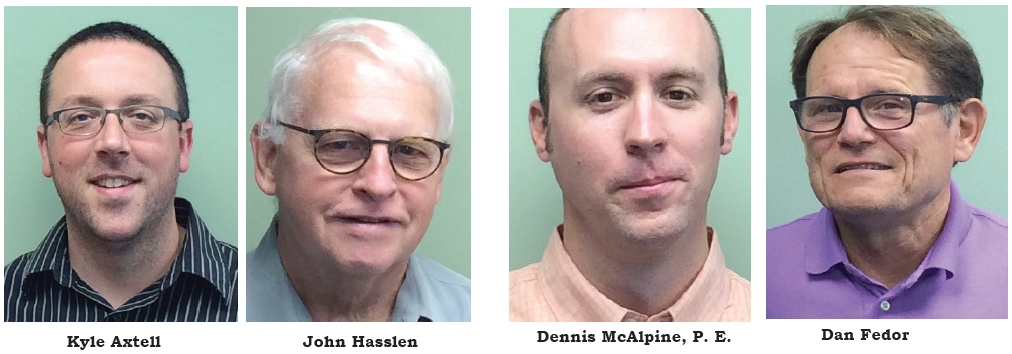by Jim Meusey
Engineering Minnesota
VOL. 51 NO. 10 2016
Dennis McAlpine, P. E., project engineer at Houston Engineering, Inc. (HEI) acknowledges he enjoys a professional challenge. He has one. And so do several other folks connected with a $3 million water management project to clean up lakes in the Rice Creek Watershed District (RCWD), as well as other projects. The district is in the north/northeast sector of the metropolitan area and includes parts of Hennepin, Ramsey, Anoka and Washington counties. Communities in the district include Arden Hills, Blaine, Columbia Heights, Forest Lake, Fridley, Roseville, Shoreview and White Bear Lake. The project area is in New Brighton just south of I-694, east of Silver Lake Road and west of Old Highway 8.
A major portion of the effort involves minimizing phosphorus in Long Lake and Pike Lake. The project is also designed to improve water quality and stop flooding. “We are going to be trying some new approaches and I expect there will be a good number of people watching us to see how everything turns out,” McAlpine observed. “Much of what we do in engineering is familiar but every once in a while you have the opportunity to confront a professional challenge. This project fits that description.”
McAlpine said the effort is a “fun and challenging” project adding there is some degree of stress in figuring out how it will all work together, and notes, “it is hard to wrap my arms around everything.” He adds the proviso, “I think this will wind up to be a very rewarding challenge. We have a good idea of how to solve the problems confronting us.”
Kyle Axtell, a project manager with RCWD, agrees the project deserves the attention it will likely receive. “The district is looking forward to being able to improve water quality in our lakes,” he said. Initially, the watershed district applied for a grant to solve its water quality problem with the Minnesota Board of Water Resources in 2014. The phosphorous problem is designed to be solved by pumping pond water through a newly constructed Iron- Enhanced Sand Filter to reduce the presence of algae in two area lakes, Long Lake and Pike Lake. “We are looking at other locations in the watershed where we have similar problems,” Axtell advised. “If our solutions for problems on this project work as planned, we are in good shape for solving the other concerns as well.”
The project represents a substantial team effort. In addition to Houston Engineering and the Rice Creek Watershed District, Maple Grove-based EPG Companies is also connected to the effort by providing equipment such as pumps, sensors and controls. Company president John Hasslen has considerable experience in finding solutions to unique problems. He heads up EPG’s design group and holds a number of patents that include the EPG SurePump Wheeled Sump Drainer used for landfill leachate removal. Hasslen points out a unique attraction of EPG’s involvement is that its equipment is not proprietary. That is significant, he adds, because if equipment installers were to go out of business, governmental agencies would be left without a recourse.
Dan Fedor is an Application Specialist with EPG and is also very involved with the project. “This is a challenge for all of us,” he pointed out. “We are trying some new approaches for solving some old problems.” He notes, for example, use of more highly sophisticated sensors are a key aspect of the solution because they are designed to improve and enhance reliability. “The sensors cut the need for technicians to continually monitor conditions and make it easier for Kyle (Axtell) and others to do the monitoring,” he said. The first step in the project is underway with the excavation of contaminated soil. Some of the contaminated soil will end up in a landfill. Work will also involve re-configuring a dam to create more volume. Depth of the area will be dropped by three feet to cut flooding.

MORE ABOUT THE PROJECT
The project facing the Rice Creek Watershed District (RCWD) has an intriguing and comprehensive background. The RCWD was provided a $3 million grant as a result of the 2008 decision of Minnesota voters to pass the Clean Water, Land and Legacy Amendment designed to protect drinking water sources as well as enhance and restore wetlands, among other things. One part involves the Hansen Park Comprehensive Water Management project that includes a series of water quality and flood control improvements to an existing dam and pond. A ditch flows through Hansen Park carrying storm water runoff from a large area to Pike Lake and Long Lake in New Brighton. A dam built in 1969 created a six-acre pond to control fl ooding and improve water quality. Over the years, the pond has filled with sediment leaving a negative impact on wildlife. Additionally, a trail around the pond is susceptible to flooding.
The projected solution is designed to reduce downstream phosphorous in nearby lakes by around 200 pounds annually and add about 35 acre-feet of new fl ood storage within the park. Specific projects include dredging and reconstruction of the Hansen Park Pond, construction of an Iron-Enhanced Sand Filter, replanting and rebuilding soil to improve wildlife habitat and reconstruction of park trails.
The project is underway and expectations are to complete the effort by the end of 2018.
